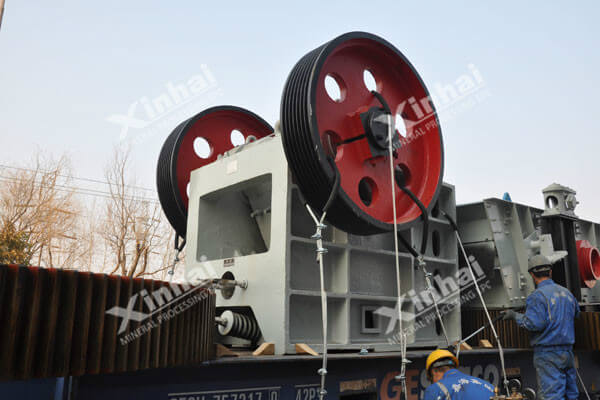

Warm Tip: If you want to know more details about equipment, solutions, etc, please click the button below for free consultation, or leave your requirements!

Crushing is the first step of mineral processing where the ore/rocks from the mine site is fed into the crushing machines in order to reduce the size of masses for subsequent usage by liberating the valuable mineral from the gangue.
In the mineral processing, ore crushing and grinding operations are essential material preparation operations before the separation process. Because the useful minerals and gangue minerals in most raw ores are disseminated, and often in the form of fine particles . Only when they are fully dissociated, can they be enriched by existing beneficiation methods. However, the grinding operation far exceeds the crushing operation in terms of production cost, capital investment and power consumption. According to statistics, the energy consumption per unit of grinding operations is up to 5 times that of crushing operations, accounting for about 85%. Therefore, many beneficiation plants have tried to follow the principle of “more crushing and less grinding” to reduce energy consumption and improve economic efficiency, which puts higher requirements on crushing machine.
With the continuous development of mineral processing technology, and there are numerous types of crushing machines , such as common jaw crusher, hammer crusher, impact crusher, cone crusher, mobile crusher, and roll crusher etc. In addition, the working principle of each crusher is different, and its application range is also different, which undoubtedly increases the difficulty of the crusher selection. Then, how should the mine owner choose the suitable crushing machine for his own beneficiation plant?
Let us know more about the choices of crusher from the following four aspects.
Different material types has different hardness and structure, which will be the first limitation to choose crushing machine. Generally, the hardness of the material is expressed in terms of Moh's hardness, divided into 10 grades. The higher the Moh's hardness is, the harder the ore is, the more difficult it is to break, and the relatively severe the wear of the crusher itself. vice versa. For example, the hammer crusher is more suitable for handling low-hardness and brittle materials, while the cone crusher is more suitable for medium-hardness materials, so cone crusher requires better crushing force and wear resistance.
Different types of crusher feed ports are different, and the size of the crusher also determines the size of the feed port. This requires the crusher manufacturer to produce crushers according to the size of the material to be crushed by the beneficiation plant. If the content of coarse particles (large dry discharge port size) in the feed is higher, the required crushing is relatively larger, which will affect the productivity to a certain extent and cause clogging; while the fine particles (close to or smaller than the size of the discharge port) have more content. The crushing to be achieved is relatively smaller, so its productivity will be correspondingly improved.
If the feed size is large and the discharge size is small, secondary or multi-stage crushing is often required. Different crushing levels also have certain requirements for the type of crushing machine. Usually, the jaw crusher is often used as a primary crusher, while the impact crusher, cone crusher, and hammer crusher are used as secondary crushing or even tertiary crushing.
When the water content is too large, the fine material will agglomerate or stick to the coarse material due to the increase in humidity, thereby increasing the viscosity of the material. When a certain viscosity is reached, the material will adhere to the crusher feed port and the crushing chamber, which greatly reduces the discharge speed, complicates the blockage of the feeding and discharging materials, and reduces the productivity. In severe cases, it will directly cause the crusher fail to work properly. In this case, the impact crusher is more competitive, and the feed chute and counter plate can be equipped with heating devices to prevent material sticking.
Simply understood, the higher the production requirements, the larger the required crushing machine specifications, and the corresponding inputs and outputs will increase. At present, the unit production range of crushers on the market is relatively large, ranging from 10 tons to hundreds or even thousands of tons. This requires the mine owner to choose which type of crushing machine to use according to the specific production requirements of the plant and how to arrange a more reasonable crushing process, striving to achieve the best investment rate.
In addition to the above four objective factors, equipment design experts also suggest that when selecting the crushing machine, the mine owner should choose a regular and well-known equipment manufacturer. At present, there are many manufacturers of crushing machines on the market, and the equipment is also mixed. The indicators produced by regular manufacturers are in line with relevant national regulations, and the equipment is more reliable. The well-known manufacturers tend to have stronger strength and advanced production technology, rich experience. Overall consideration is more cost-effective.
The mine owners need to take the above-mentioned factors including material properties, beneficiation plant requirements, production and manufacturer strengths into consideration and make overall thinking. Never ever blindly follow other beneficiation plants. After all, mine owners still need to comprehensively analyze the actual situation of the beneficiation plant, and combine their own investment budget and expected results to select the best crushing machine.
Last: Influence of Hydrocyclone Structure on Classifying Effect
18 Factors That Affect Production Efficiency of Crushers
 0
0
 3062
3062
2How to Choose Suitable Crushing Machine?
 3
3
 3072
3072
3What Are Common Types of Crushers Used in the Mineral Processing?
 0
0
 3975
3975
